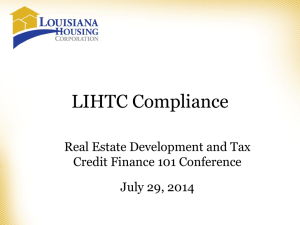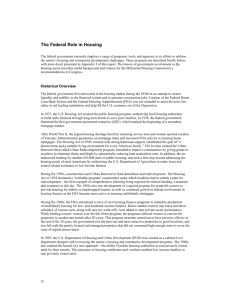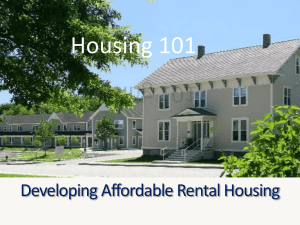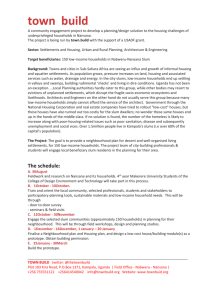Document 14933075
advertisement
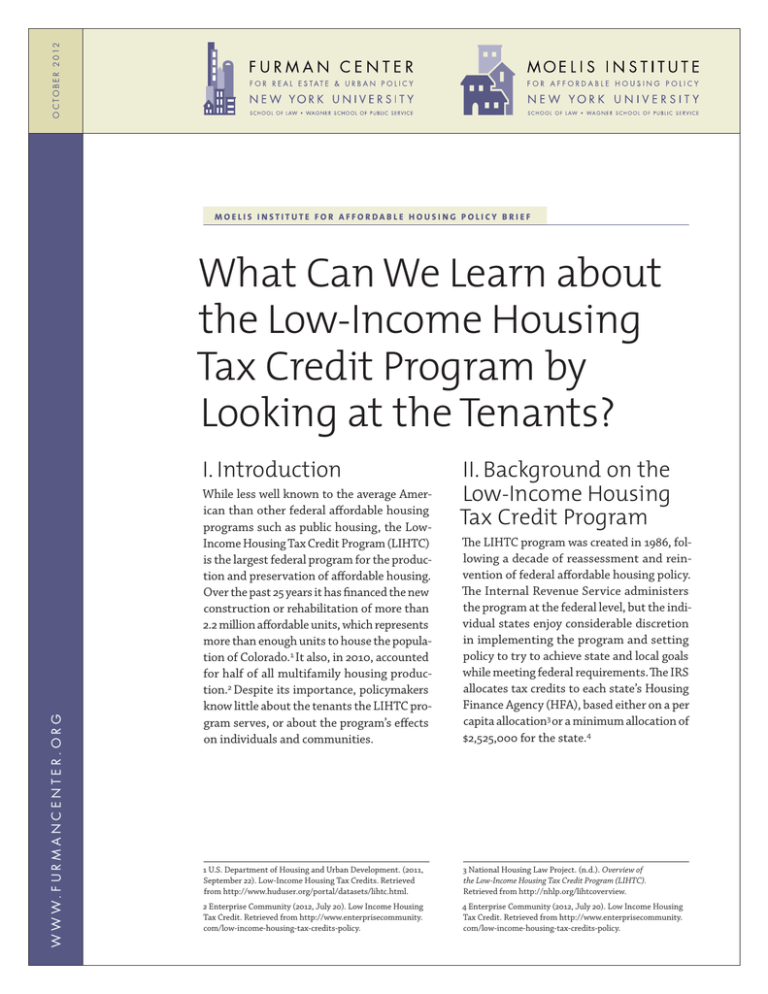
OCTOBER 2012
M O E L I S
I NSTITUTE FOR AFFORDABLE HOUSI NG POLICY BRI EF
What Can We Learn about
the Low-Income Housing
Tax Credit Program by
Looking at the Tenants?
W W W. F U R M A N C E N T E R . O R G
I. Introduction
While less well known to the average American than other federal affordable housing
programs such as public housing, the LowIncome Housing Tax Credit Program (LIHTC)
is the largest federal program for the production and preservation of affordable housing.
Over the past 25 years it has financed the new
construction or rehabilitation of more than
2.2 million affordable units, which represents
more than enough units to house the population of Colorado.1 It also, in 2010, accounted
for half of all multifamily housing production.2 Despite its importance, policymakers
know little about the tenants the LIHTC program serves, or about the program’s effects
on individuals and communities.
II. Background on the
Low-Income Housing
Tax Credit Program
The LIHTC program was created in 1986, following a decade of reassessment and reinvention of federal affordable housing policy.
The Internal Revenue Service administers
the program at the federal level, but the individual states enjoy considerable discretion
in implementing the program and setting
policy to try to achieve state and local goals
while meeting federal requirements. The IRS
allocates tax credits to each state’s Housing
Finance Agency (HFA), based either on a per
capita allocation3 or a minimum allocation of
$2,525,000 for the state.4
1 U.S. Department of Housing and Urban Development. (2011,
September 22). Low-Income Housing Tax Credits. Retrieved
from http://www.huduser.org/portal/datasets/lihtc.html.
3 National Housing Law Project. (n.d.). Overview of
the Low-Income Housing Tax Credit Program (LIHTC).
Retrieved from http://nhlp.org/lihtcoverview.
2 Enterprise Community (2012, July 20). Low Income Housing
Tax Credit. Retrieved from http://www.enterprisecommunity.
com/low-income-housing-tax-credits-policy.
4 Enterprise Community (2012, July 20). Low Income Housing
Tax Credit. Retrieved from http://www.enterprisecommunity.
com/low-income-housing-tax-credits-policy.
2
What Can We Learn about the Low-Income Housing Tax Credit Program by Looking at the Tenants?
© City of NY/Dept. of Housing Preservation & Development (Photo by L. Racioppo)
The LIHTC program differs from other federal housing programs in some key ways. First,
LIHTC income eligibility limits are generally
higher. As in other programs administered by
the U.S Department of Housing and Urban
Development (HUD), LIHTC income limits
are based upon the area median income (AMI)
that HUD sets for every county and metropolitan area. Households earning at or below
30 percent of AMI are defined as “extremely
low-income” (ELI), those earning between
31 and 50 percent of AMI as “very lowincome” (VLI), and those earning at or below
80 percent of AMI as “low-income.”5
HUD Income Limits
Income Limit
Definition
Extremely Low-income (ELI)
Income at or below
30 percent of AMI
Very Low-income (VLI)
Income between 31 and 50 percent of AMI
Low-income Income at or below 80 percent of AMI
Using HUD’s AMI for the jurisdiction, LIHTC
developers are required to choose between the
20-50 rule, which requires at least 20 percent
of the units to be rent restricted and occupied by households with incomes at or below
50 percent of AMI, or the 40-60 rule, which
requires at least 40 percent of the units to be
rent restricted and occupied by households
with incomes at or below 60 percent of AMI.
5 Novoco. Income Limits—Frequently Asked Questions.
Retrieved from http://www.novoco.com/low_income_housing/
resource_files/income_limits/2012_faqs.pdf.
By contrast, federal law requires that 40 percent of new public housing entrants and 75
percent of section 8 voucher recipients must
have incomes at or below 30 percent of AMI.
A second distinguishing feature of the LIHTC
program is that rents are not tied to a tenant’s
income. In HUD-subsidized programs, rents
are generally set at 30 percent of the tenant’s
income (the generally accepted standard for
an affordable rent), but in the LIHTC program, maximum chargeable rents are set at
30 percent of either 50 percent or 60 percent
of AMI, depending on which income limit was
applied to that unit at the time the credits
were awarded to the development. See “How
Rent Caps Are Set for the LIHTC Program”
on page 4, for an example.
III. The Sixteen States
We Studied
Each state allocating agency oversees annual
compliance with program requirements,
including income and rent restrictions and
quality standards for developments. The Housing and Economic Recovery Act (HERA) of
2008 required state housing finance agencies to begin reporting tenant incomes and
rents to HUD.6 Through a partnership with
the National Council of State Housing Finance
Agencies and its members, the Furman Center
6 States have also been required to begin gathering tenant
race and ethnicity data, which will first be mandatory in
2011 tenant data.
was able to analyze data on the incomes of
tenants in 16 states. In all, the states in our
analysis cover more than 12,000 properties,
thirty-eight percent of the total LIHTC housing stock.7 Our examination of the data suggests that these properties are fairly representative of the LIHTC universe in terms of
the size of developments, geographic distribution, owner type, and location (e.g. in a city,
suburb, or rural area.) Thus, our results should
be generalizable to the LIHTC program as a
whole (see Table 1).8
Key Findings
n More than forty percent of LIHTC units
house extremely low-income (ELI) households.
n Rental assistance in addition to the LIHTC subsidy plays a large role in serving low-income households. More than
70 percent of extremely low-income
households are in units receiving some
form of additional rental assistance.
n LIHTC tenants experience lower rent Table 1: LIHTC Sample Description
All LIHTC units
Total Developments
Total Units
16 State Sample
33,777
12,228
2,027,838
762,695
Average Development Size
60
62
burdens than other households of similar incomes, but higher rent burdens
than other HUD tenants. Rent burdens,
which vary by income and rental assistance, are highest for LIHTC tenants
earning between 30-40 percent of AMI.
3
What Can We Learn about the Low-Income Housing Tax Credit Program by Looking at the Tenants?
Region
Northeast
13.5%
9.6%
Midwest
22.7%
21.8%
South 39.8%
48.2%
West
23.9%
20.4%
Geographic Distribution
Central City
50.8%
45.3%
Suburb
34.5%
41.8%
Rural
14.7%
13.0%
Developer Type
For-Profit
80.0%
75.1%
Non-Profit
20.0%
24.9%
Source: HUD data
7 O’Regan, K. & Horn, K. (2012). What Can We Learn about
the Low Income Housing Tax Credit Program by Looking at the
Tenants? Retrieved from http://furmancenter.org/files/publications/LIHTC_paper_July_2012_1_1.pdf.
8 Few studies to date have analyzed LIHTC tenant income
data and those that did looked at a limited set of properties.
The U.S. General Accounting Office (GAO) conducted a study
in 1997 examining the tenant characteristics for 423 LIHTC
properties. Abt Associates conducted a study in 2000 looking at
39 LIHTC properties. Williamson, Smith and Strambi-Kramer
(2009) and Williamson (2011) conducted more recent studies
of tenant incomes in LIHTC properties in Florida. See U.S.
General Accounting Office. (1997). Tax Credits Opportunities
to Improve Oversight of the Low-Income Housing Program.
Retrieved from http://www.gao.gov/archive/1997/g597149t.pdf.
Williamson, Anne, Marc Smith and Marta Strambi-Kramer.
(2009). “Housing Choice Vouchers, the Low-Income Housing
Tax Credit and the Federal Poverty Deconcentration Goal,”
Urban Affairs Review, 45(1), 119-132. Williamson, Anne R. (2011).
“Can They Afford Rent? Resident Cost Burden in Low Income
Housing Tax Credit Developments,” Urban Affairs Review,
20(1), 1-25.
IV. A Closer Look at
LIHTC Tenants
What are the incomes of the households
served by the LIHTC Program?
The dearth of affordable housing for extremelyand very- low-income households has been
well-documented in recent decades. HUD’s
most recent Worst Case Housing Needs report
shows that between 2007 and 2009, the number of extremely low-income renters (below 30
percent of AMI) who paid more than half their
income to rent, live in severely inadequate
housing, or both, increased from 4.33 million to 5.07 million.9 Competition for affordable housing remains fierce as higher income
households often occupy units affordable to
lower income renters. This means that, nationwide, only 32 units of adequate, affordable
rental housing are available for every 100
extremely low-income renters.
Given the significant need for housing affordable to extremely low-income households and
the lack of information about the tenants living in LIHTC developments, advocates and
policymakers have rightly asked whether the
9 U.S. Department of Housing and Urban Development.
(2011, February). Worst Case Housing Needs 2009: Report to
Congress. Retrieved from http://www.huduser.org/Publications/pdf/worstcase_HsgNeeds09.pdf.
Figure 1: Household income for LIHTC households
How Rent Caps Are Set for the LIHTC Program
n 0-30% ami n 31-40% ami n 41-50% ami n 51-60% ami n 61% ami or above
7%
14%
43%
18%
4
What Can We Learn about the Low-Income Housing Tax Credit Program by Looking at the Tenants?
19%
LIHTC program actually reduces worst case
housing needs. As seen in Figure 1, our analysis finds that a significant portion of LIHTC
units, or just over 40 percent, serve extremely
low-income households. While this share is
less than the roughly 75 percent of units in
HUD’s public housing and Housing Choice
Voucher programs that serve extremely lowincome households, it amounts to a much
larger number of units for extremely lowincome households than the 20/50 or 40/60
rules require.10
Because the percentage of LIHTC units occupied by extremely low-income households
was higher than required, we delved deeper
into the data and sorted tenants into more
fine-grained categories of income. The HUD
income definition for very low-income households is broad (between 31 and 50 percent of
AMI). This category groups households with
incomes just below 50 percent of AMI, who we
might expect to live in LIHTC housing given
the 20/50 and 40/60 rules described previously,
with those whose incomes are just above 30
percent of AMI. Our finer categories of income
show that 62 percent of tenants have incomes
at or below 40 percent of AMI, far below the
LIHTC income limits. In other words, almost
two-thirds of LIHTC units serve households
whose incomes fall well below the maximum
permitted income levels.
10 U.S. Department of Housing and Urban Development.
Housing Choice Vouchers Fact Sheet. (n.d.) Retrieved from http://
portal.hud.gov/hudportal/HUD?src=/topics/housing_choice_
voucher_program_section_8.
The LIHTC program sets maximum rents for
units based on the income level at which
the unit (rather than an occupant) qualifies for the program. For example, for a unit
allocated tax credits based on being affordable at 50 percent of AMI, its maximum
rent is set so that a household with an
income equal to 50 percent of AMI would
be paying 30 percent of their income in
rent. If 50 percent of the AMI for the jurisdiction equals $32,000, therefore, the maximum rent would be set at $9,600.
Because the rent is set for the unit, rather
than the household actually living in the
unit, a household occupying the unit may
have an income lower than 50 percent,
and therefore may pay more than 30 percent of its income for housing (or secure
rental assistance to help pay the amount in
excess of 30 percent). For example, a household with an income of only $19,200 (30
percent of AMI), if paying the maximum
rent, would have a rent burden that is 50
percent of their income.
It is worth noting that to qualify for this
unit a household would need an income no
greater than 50 percent of AMI. For households even quite close to the limit – say, at
48 or 49 percent of AMI, their resulting rent
burden would be just above 30 percent.
Reaching extremely low-income households: Rental assistance
Given that the LIHTC program sets income
limits at 50 percent and 60 percent of AMI,
how is it that this program is serving so many
extremely low-income households? In this
section, we explore one strategy for making LIHTC housing affordable for extremely
low-income households—rental assistance.
Rental assistance includes place-based rental
subsidies tied to the unit, and tenant-based
assistance such as vouchers that are linked
to the household.
We find that rental assistance plays a significant role in allowing LIHTC developments
to serve extremely low-income households.
Nearly 70 percent of extremely low-income
households are in units that receive some
Figure 2: Share of LIHTC Households in Different Income Bands Receiving Rental Assistance
At or Below 30% AMI
80
100
120
31-40% AMI
41-50% AMI
At or Above 51% AMI
At or Above 61% AMI
0%
10%
20%
30%
40%
50%
60%
70%
Figure 3: Rent Burden by Income, LIHTC Sample Households Versus All Renter Households Nationally
n Rent burden at or below 30% n Rent burden between 31%-50% n Rent burden at or above 51%
LIHTC tenants: At or below 30% AMI 49.4%
All U.S. renters: At or below 30% AMI 23%
16%
63%
LIHTC tenants: Between 31-50% AMI 25.1%
63.1%
All U.S. renters: Between 30-50% AMI 25%
5
What Can We Learn about the Low-Income Housing Tax Credit Program by Looking at the Tenants?
LIHTC tenants: At or above 51% of AMI 20.1%
30.6%
46%
37%
53.1%
46.7%0.2%
All U.S. renters: Between 50-80 AMI 59%
0%
20%
form of rental assistance (see Figure 2).11 In
contrast only 10 percent of LIHTC residents
with incomes above 50 percent of AMI live
in units with rental assistance. This suggests
that rental assistance is indeed targeted to
extremely low-income households, which is
worth noting because unlike federal placebased rental assistance or Section 8 vouchers, state rental assistance programs may
have different targeting criteria. The share
of extremely low-income households served
by LIHTC varies by state; and in states with
more resources dedicated to rental assistance
LIHTC developments typically serve more
extremely low-income households.
11 The tenant data includes information on whether the landlord
receives rental assistance payments for the unit. This includes
place-based rental assistance and tenant-based assistance, from
any source (federal, state, and local). We are unable to distinguish
the type of rental assistance, but know the amount, for the 9
states in our sample with rental assistance data.
40%
11.7%
37%
6%
60%
80%
100%
Tenant rent burdens in LIHTC properties
Overall, extremely low-income households
in LIHTC housing (including those with
rental assistance) experience rent burden
levels that are markedly higher than those
tenants in HUD programs experience.12 In
Figure 3 though we see that the rent burdens extremely low-income tenants in LIHTC
housing face nevertheless are substantially
lower than what extremely low-income renters generally experience, with 63 percent of
all extremely low-income renter households
(including subsidized renters) paying more
than 51 percent of their income to rent.
12 A 1990 GAO study suggests that in fact, only 15 percent of
public housing residents experienced rent burdens greater than
33 percent. U.S. General Accounting Office. (1990). Assisted
Housing: Rent Burdens in Public Housing and Section 8 Housing
Programs. Retrieved from http://www.gao.gov/assets/220/212625.
pdf. More recent work by Kirk McClure (2005) suggests that 38
percent of voucher holders faced rent burdens greater than 31
percent, and 18 percent face burdens greater than 40 percent
(due in part to particularly low-incomes and requirements of
minimum rent payments). See McClure, Kirk. (2005). “The Low
Income Housing Tax Credit Goes Mainstream and Moves to the
Suburbs.” Housing Policy Debate 11(1):91-114.
What Can We Learn about the Low-Income Housing Tax Credit Program by Looking at the Tenants?
Figure 4: Extremely Low Income Tenants in LIHTC Properties: Rent Burdens for Households without Rental Assistance
70%
Households with
Rental Assistance
30%
Households
without Rental
Assistance
{
Relative to the extremely low-income households addressed in Figure 4, fewer households
with incomes over 30 percent of AMI receive
rental assistance. We see in Figure 5 that this
has a pronounced impact on households just
above the extremely low-income income
threshold. Only 30 percent of these households (those with incomes of 30-40 percent
of AMI) receive rental assistance, and many
face high rent burdens as a result. We find that
three out of four households whose incomes
are between 30 and 40 percent AMI face rent
burdens above 35 percent. What’s more, only
11 percent of these households pay less than
30 percent of their income to rent. For higher
income households above 40 percent of AMI,
Figure 5 shows that severe rent burdens are
rare even without rental assistance, though
over half experience moderate rent burden,
defined as a rent burden between 30 percent and 50 percent of a household’s income.
57%
Rent burden
above 50%
29%
Rent burden
between 31%-50%
14%
Rent burden below 30%
We also see that almost three-fourths of these
higher-income households have rent burdens
of 35 percent of income or less, while 47 percent experience rent burdens of 30 percent
of income or less.
Figure 5: Rent Burdens by Income
n Rent burden at or below 30% n Rent burden between 31%-50% n Rent burden at or above 51%
120
6
00
Figure 2 showed that serving extremely lowincome households generally requires relying
on rental assistance. Figure 4 further illustrates that, in the absence of rental assistance,
extremely low-income households often pay
rents above the 30 percent level that is generally accepted as “affordable.” The critical role
rental assistance plays in minimizing rent burdens is evident in Figure 4. Among the 30 percent of extremely low-income households who
do not have rental assistance, more than half
pay over 50% of their income as rent, which
is defined as a “severe” rent burden.
At or below 30% AMI
31-50% AMI
At or Above 51% of AMI
49.4%
25.1%
0%
20%
20.1%
30.6%
63.1%
53.1%
40%
11.7%
46.7%0.2%
60%
80%
100%
V. Where Do We Go
from Here: Policy
Implications
7
What Can We Learn about the Low-Income Housing Tax Credit Program by Looking at the Tenants?
Our findings demonstrate that the LIHTC program serves a significant number of extremely
low-income households, perhaps more so
than members of the affordable housing field
had anticipated. Both the fact that so many
extremely low-income households live in
LIHTC housing and the methods HFAs and
LIHTC sponsors have used to serve them have
implications for LIHTC policy going forward.
First, our findings show that the LIHTC program is an important tool to provide housing
to those with the greatest need for affordable
housing. On its own though, this tool does not
reach a significant number of extremely lowincome households without those households
experiencing rent burdens. Rental assistance
is currently an indispensable part of the equation to serve those households. Shrinking budgets at both the state and federal levels will
make it unlikely that additional resources will
be available for rental assistance dedicated to
LIHTC properties. Additional resources to subsidize rents for extremely low-income households could take alternative forms, however.
The U.S. Department of Treasury has recommended changes to the program in its FY2013
Revenue Proposals, for example, that would
permit income from higher rent units to subsidize rents of extremely low-income households within LIHTC projects.13 Policymakers should continue to look for creative ways
to provide opportunities for extremely lowincome households to live in LIHTC housing
without facing excessive rent burdens.
The layering of rental assistance with LIHTC,
while necessary to serve extremely lowincome households, also presents challenges
to policymakers. Layering a rental assistance
subsidy on top of LIHTC subsidies may result
13 U.S. Department of Treasury. (February 2012). General
Explanations of the Administration’s Fiscal Year 2013 Revenue
Proposals. Retrieved from http://www.treasury.gov/resourcecenter/tax-policy/Documents/General-Explanations-FY2013.
pdf. Proposal is entitled “Encourage Mixed Income Occupancy
by Allowing LIHTC-Supported Projects to Elect a Criterion
Employing a Restriction on Average Income.”
in additional compliance requirements, and
impose additional costs on owners and managers. This suggests that policymakers should
examine any administrative obstacles LIHTC
owners and developers face in using rental
assistance in LIHTC properties and seek to
minimize them.
The combination of LIHTC and rental assistance subsidies to serve extremely low-income
households means that the costs and benefits of the LIHTC program are harder to isolate. To accurately compare the effectiveness
of housing extremely low-income households
in different affordable housing programs, it
is crucial to understand the ways in which a
housing development may draw upon subsidies from multiple programs.
The presence of a significant number of
extremely low-income households in LIHTC
properties means that these properties should
be included in discussions about targeting services to households that receive housing subsidies. At the state, local and national levels
policymakers are looking for ways to improve
the efficiency of service provision, and cut
costs, by providing health care or other services in or near subsidized housing. These discussions should include LIHTC properties in
addition to other forms of subsidized housing.
Further, the fact that LIHTC developments
serve such large numbers of extremely lowincome households suggests that the discretion states have in setting priorities about
how to allocate their credits is not undermining federal priorities for serving lowest
income tenants. Whether federal priorities are
being furthered because many states include
serving extremely low-income households as
an explicit priority in their Qualified Allocation Plans, or because of other aspects of the
LIHTC program, requires additional analysis.
But the issue of how the states’ role in the
implementation of the LIHTC program affects
federal interests is a crucial one for housing
policy, which often struggles to strike the
right balance between federal control and deference to state and local expertise and preferences. Our findings suggest that a model
where the federal government sets goals but
8
What Can We Learn about the Low-Income Housing Tax Credit Program by Looking at the Tenants?
allows the states discretion in implementing
the program can achieve federal interests.
Lastly, our findings suggest that the conventional wisdom about many aspects of
the LIHTC program may not hold. Further
research is needed to identify the key benefits and costs of the program. Among the
most pressing areas of inquiry are:
• Do LIHTC properties provide low-income
households with access to neighborhoods
of opportunity?
• Does such access to neighborhoods of
opportunity differ for particular populations, such as minorities, those with
extremely low incomes, and families or the
elderly?
• Do LIHTC properties contribute to the
deconcentration, or concentration, of poverty or minority groups?
• How does access to LIHTC housing benefit tenants in terms of housing cost burden
and residential stability?
• Do the priorities states set forth in their
Qualified Allocation Plans (QAPs) affect
LIHTC outcomes?
• How can the costs of LIHTC housing, including the average cost of construction per unit
of LIHTC developments, be reduced?
• How do the benefits of lower rents compare to the costs of public dollars for this
program, and how does this vary by housing markets and tenants served, development characteristics, and specific priorities set forth in state QAPs?
• What is the most efficient and effective way
to preserve the affordability and quality of
LIHTC developments reaching year 15 and
year 30?
We plan to examine each of these questions
over the next few years.
Acknowledgements
We would like to thank the National
Council of State Housing Finance Agencies and the states that supplied us with
data on the incomes of tenants living
in LIHTC developments that made this
research possible. We would also like to
thank the Robert F. Wagner Graduate
School of Public Service for its support
of this project.
About the Furman Center and Moelis Institute
for Affordable Housing Policy
The Furman Center for Real Estate and Urban Policy is a joint center of the New York University
School of Law and the Robert F. Wagner Graduate School of Public Service at NYU. Since its
founding in 1995, the Furman Center has become a leading academic research center devoted
to the public policy aspects of land use, real estate development, and housing. The Furman
Center launched the Moelis Institute for Affordable Housing Policy to improve the effectiveness of affordable housing policies and programs by providing housing practitioners and
policymakers with information about what is and is not working, and about promising new
ideas and innovative practices.
furmancenter.org

